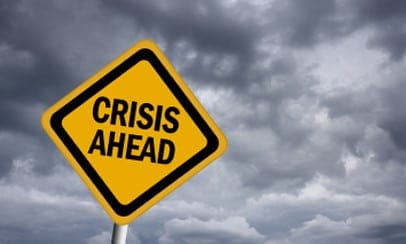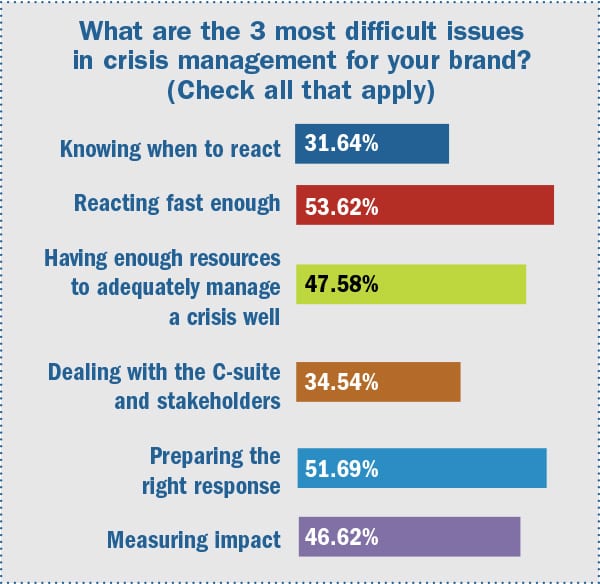
Editor’s Note: Prior to PRNEWS’ Crisis Summit in late February in Miami Beach, PRNEWS and partner Crisp, a social media issue detection and crisis monitoring firm, convened a Communications Leadership Roundtable. During the 90-minute session, 21 senior communicators exchanged views on trends, developments and best practices in PR crisis management. Major themes and discussions are summarized below. Per agreement, the participants’ remarks are unattributed.
When and How to React
Similar to results seen in the PRNEWS-Crisp crisis survey (see PRNEWS, March 2019 edition, and accompanying chart in this article), the executives provided a wide range of answers when moderators opened the session with a question about the biggest challenges in crisis management.
“Knowing when to react to something you’ve seen on social is the toughest” issue, one executive said. Another added, “The biggest problem for us is knowing when something is a legitimate issue or the isolated ranting of a few people with small followings.”
Another communicator pointed to the need for PR to be able to separate authentic social conversations and trends from bot activity, misinformation and fake news. “It’s important to listen and assess a situation before committing to taking action,” one communicator said, “but it’s getting more difficult with all the noise out there.”
And then there’s the rub: “You want to do your listening but you also can get killed if you wait too long,” the same communicator added. Another noted the difficulties involved in executing a timely response when bureaucratic and legal hurdles are involved. “Sometimes it’s a lot of hurry up and wait,” one said.
Beyond knowing when and if to respond, striking the correct tone in the response also was cited as a major challenge.

Inside and Outside Listening
There was lively discussion and agreement about the fact that communicators need to be constantly listening outside and within the enterprise. “There’s no substitute for building relationships with HR and operations, so you can assess where potential risks are,” one communicator said.
Another added that having strong relationships if and when a crisis occurs can be invaluable. “They can save you a lot of time,” when you have to reach out to particular departments within the company, the communicator added.
Another communicator mentioned the difficulty of having enough human resources to respond to a crisis, and those around the table agreed. “We’re stretched thin already…having us on 24/7 [during a crisis] makes it even more difficult,” one participant said. Another added, “The amount of information about your brand coming at you during a crisis is tremendous. It’s like someone opened a fire hydrant. Having enough hands to monitor all that information is absolutely necessary.”
There were a lot of heads nodding in agreement when one communicator made a related point about resources: “The hardest thing for us…is [finding resources to continue doing the day-to-day work of communications] while also managing a crisis.”
Slipping Through the Cracks
In a related discussion, another executive added that making sure normal issues don’t “slip through the cracks” during a crisis is a challenge. “Having pre-arranged rotations and plans for where every member of the communications team should be during a crisis” as part of your crisis-management plan can mitigate this issue, since you can plan to have a skeleton crew handle day-to-day issues, an executive said.
When the group was asked about ways to get larger budgets for crisis management, the consensus centered on presenting case studies to the C-suite showing the financial effects of PR crises that were poorly handled. “Relating crisis to the bottom line is a very effective way to get attention to the need for budget” increases for crisis management, training and other kinds of preparation, several communicators said.
Crisis Hand-Off
Several communicators who work at multinational companies said they consider themselves fortunate in that they can hand off crisis work to colleagues in other time zones when the hour is late.
On the other hand, more than a few executives discussed the difficulties in maintaining a consistent message during a crisis when colleagues from other parts of the world are involved. “Sometimes it’s a cultural thing…[overseas departments] just do things differently…sometimes it’s just a translation issue,” one said.
Several PR pros also mentioned the difficulties of working on an overseas crisis due to time zone issues and delays that occur when public statements require translation. Then there’s the issue of waiting for approval, which seems compounded when “you’re waiting to hear from someone overseas,” an executive said.
The C-Suite and Crisis
Working with the C-suite during a crisis was a continuing theme in the discussion, though the consensus was that this wasn’t a major difficulty. Still, some communciators voiced complaints. “It’s sometimes hard to keep our CEO on point” during a crisis, one communicator said.
Another noted the importance of not having the CEO or other C-suite members involved in a crisis committee at the outset of a response. The presence of a senior player likely will inhibit other members of the team from speaking freely about the situation, one communicator argued.
“Bring the CEO [or other C-suite executives] in, perhaps to speak to the media, only after you’ve discussed the situation and decided how to respond,” this communicator said.
Rebuilding Reputation
Once a crisis is over, the job of rebuilding a brand’s reputation, the communicators agreed, is one of the most difficult. “Even more than one year” after a crisis, when some media members write about our company, they mention the crisis in their story, one said.
“A crisis doesn’t really ever go away,” another PR pro said in agreement. Another noted this is due partly to digital technology. When a reporter uses Google to research a company, it’s not too difficult to find mention of a crisis if one occurred in the not-too-distant past, several of the communicators said.
Still, the key, the group agreed, is building and maintaining strong relationships with media so you can tell your brand’s story during a crisis.
Others mentioned the importance of having deep relationships with influencers and other stakeholders. “[Influencers and outside stakeholders] can help you tell your story during a crisis. It’s good to have someone from outside the company doing that,” an executive said.
Unintentional Crisis
A point resonated from a discussion about how brands can be dragged into a crisis unintentionally, such as when this is brought on by outside forces. But it can also come from within—one communicator noted how several senior executives expressed political views on social and those became associated with the brand. “Our brand doesn’t have a political view, but the public thinks it does,” the communicator said.
Another communicator built on that point, noting how it is admirable and probably necessary for brands to take stands on social issues. Still, this communicator said, “Sometimes I’d prefer our brand played it down the middle [on social issues],” noting how taking a stand can complicate the public’s view of the brand and can also lead to a PR crisis.
There was a brief discussion about measurement and crisis. About half the PR execs said they measure their efforts to manage crises, though many also said they’ve yet to find an effective way to place a value on success in keeping damaging stories out of the media.

